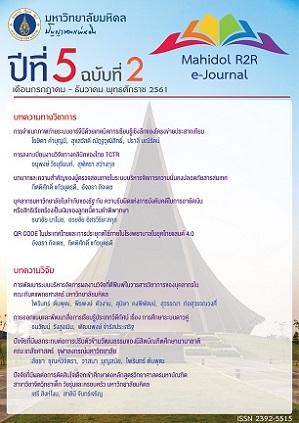บทบาทและความสำคัญของผู้ตรวจสอบภายใน ระบบบริหารจัดการความมั่นคงปลอดภัยสารสนเทศ
DOI:
https://doi.org/10.14456/jmu.2018.14คำสำคัญ:
การตรวจสอบภายใน, ผู้ตรวจสอบภายใน, ระบบบริหารจัดการความมั่นคงปลอดภัยสารสนเทศบทคัดย่อ
ในปัจจุบันเทคโนโลยีสารสนเทศได้มีการพัฒนาไปอย่างรวดเร็วและเข้ามามีบทบาทสำคัญในการดำเนินงานขององค์กรต่าง ๆ ทำให้การรักษาความปลอดภัยของระบบสารสนเทศได้กลายเป็นประเด็นที่สำคัญสำหรับองค์กรต่าง ๆ ในประเทศไทย และในหลาย ๆ ประเทศ เพื่อเป็นการป้องกันการเข้าถึงข้อมูลที่สำคัญต่าง ๆ จึงต้องปฏิบัติตามข้อกำหนดด้านความปลอดภัยสารสนเทศ อย่างไรก็ตามองค์กรต้องเผชิญกับปัญหาต่าง ๆ ในปรับปรุงระบบบริหารจัดการความมั่นคงปลอดภัยระบบสารสนเทศให้ได้ตามมาตรฐานข้อกำหนด
ระบบบริหารจัดการความมั่นคงปลอดภัยสารสนเทศ (Information Security Management System: ISMS) หรือ ISO/IEC 27001:2013 คือมาตรการในการรักษาความปลอดภัยระบบสารสนเทศ ถือเป็นหัวใจหลักในการบริหารจัดการระบบเทคโนโลยีสารสนเทศขององค์กร และได้ถูกนำมาใช้เป็นมาตรฐานในการบริหารจัดการด้านความมั่นคงปลอดภัยสารสนเทศอย่างแพร่หลาย ซึ่งหนึ่งในกระบวนการที่สำคัญที่ทำให้การดำเนินโครงการดังกล่าวประสบความสำเร็จ คือการตรวจสอบภายใน ซึ่งถือเป็นปัจจัยสำคัญของการควบคุมคุณภาพภายในขององค์กร ทำให้การตรวจประเมินมีความเป็นอิสระ และตรงตามวัตถุประสงค์ของการตรวจสอบภายใน ทำให้การควบคุม ติดตามการดำเนินกิจกรรมต่าง ๆ ให้มีประสิทธิภาพ และประสิทธิผล
ดังนั้น ผู้ตรวจสอบภายในถือเป็นหัวใจสำคัญในการผลักดัน ส่งเสริมการปฏิบัติงานให้บรรลุวัตถุประสงค์และเป้าหมายขององค์กร ที่จะนำระบบบริหารจัดการความมั่นคงปลอดภัยระบบสารสนเทศมาใช้ เช่น ส่งเสริมให้เกิดกระบวนการกำกับดูแลที่ดี (Good Corporate Governance), ส่งเสริมให้เกิดการรายงานตามหน้าที่ความรับผิดชอบ (Accountability and Responsibility), ส่งเสริมให้เกิดประสิทธิภาพและประสิทธิผลของการปฏิบัติงาน (Efficiency and Effectiveness of Performance), เป็นมาตรการถ่วงดุลแห่งอำนาจ (Check and Balance) และ ให้สัญญาณเตือนภัยล่วงหน้า (Warning Signals) ของการประพฤติมิชอบหรือการทุจริตในองค์กร
เอกสารอ้างอิง
2. ALshbiel, S.O. (2017). Internal Auditing Effectiveness Success Model: A Study on Jordanian Industrial Firms. Al al-Bayt University, Jordan.
3. Berber, N., & Vugdelija, V. K. (2012). Internal Audit of Compensations and Benefits: Tasks and Risks in Production Systems. Inzinerine Ekonomika-Engineering Economics. 23(4), 414-424.
4. Brown, R. (2009). A History of Accounting and Accountants. Edinburgh: General Books LLC.
5. Cascarino, R. (2007). Internal Auditing: An Integrated Approach. (2nd ed.). Lansdowne, South Africa: Juta and Company Ltd.
6. Fountain, L. (2016). Leading the Internal Audit Function: Volume 1 of Internal Audit and IT Audit. Broken Sound Parkway, NW: CRC Press.
7. Gracyalny, S. (2009). Guide to Internal Audit. (2nd ed.). California, CA: Protiviti Inc.
8. International Organization for Standardization. (2018). ISO Survey of certifications to management system standards. Retrieved from https://isotc.iso.org/livelink/livelink?func=ll&objId=18808772&objAction=browse&viewType=1.
9. Mautz, R. K. (Robert Kuhn) & Sharaf, Hussein A. (1961). The philosophy of auditing. Florida: American Accounting Association.
10. Moeller, R. R. (2009). Brink's Modern Internal Auditing: A Common Body of Knowledge. (7th ed.). Hoboken, New Jersey: John Wiley & Sons, Inc.
11. Obert, S. & Munyunguma, I. N. (2014). Internal Audit Perceptions and Their Impact on Performance of the Internal Audit Function. IOSR Journal of Business and Management, 16(5), 81-85.
12. Pedneault, S. (2009). Techniques and Strategies for Understanding Fraud. (3rd ed.). Hoboken, NJ: John Wiley & Sons, Inc.
13. Ramamoorti, S. (2003). Research Opportunities in Internal Auditing. Florida: The Institute of Internal Auditors.
14. Ridley. J. (2008). Cutting Edge Internal Auditing. West Sussex, England: John Wiley & Sons.
15. Russell, J.P. (2007). The Internal Auditing Pocket Guide, Second Edition: Preparing, Performing, Reporting, and Follow-up. (2nd ed.). Milwaukee, WI: ASQ Quality Press.
16. Swinkels, W. H. A. (2012). Exploration of a theory of internal audit: a study on the theoretical foundations of internal audit in relation to the nature and the control systems of Dutch public listed firms Delft: Published doctoral dissertation, University of Amsterdam, Netherlands.
17. Williams, E.J. (2002). The Impact of Globalization on Internal Auditors: The Evolution of Internal Auditing. Brigham Young University, USA.
ดาวน์โหลด
เผยแพร่แล้ว
ฉบับ
ประเภทบทความ
สัญญาอนุญาต




